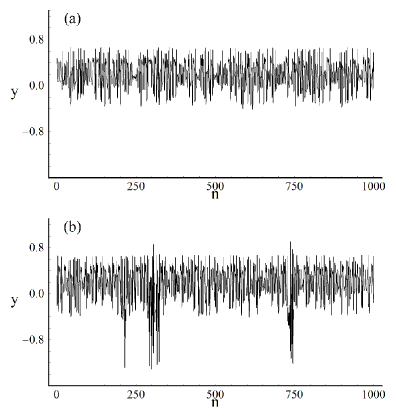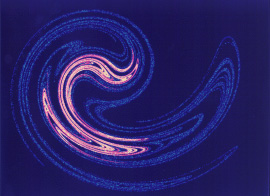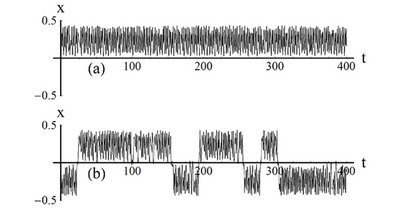Crises
 From Scholarpedia
From Scholarpedia Considering a dynamical system with a chaotic attractor, qualitative changes (bifurcations) of such attractors can occur as a system parameter is varied. Very commonly, these changes occur due to the collision of the chaotic attractor with an unstable invariant set, typically an unstable periodic orbit (equivalently, a collision with the stable manifold of the unstable periodic orbit). Such events are called crises (Grebogi et al. 1983; Ott 2002). Here by a collision, we mean that for a system parameter \(p\) below (or above) a critical crisis value, \(p_c\ ,\) the attractor does not contain the unstable periodic orbit with which it collides, but that, at \(p=p_c\) the attractor does contain it (here we define an attractor as the closure of an orbit originating from a typical initial condition in its basin of attraction).
Crisis bifurcations of chaotic attractors are extremely common and have been observed in a host of experimental settings (an early example is Ditto et al. 1983). In general, crises result in discontinuous changes in the chaotic attractor, and different types of crises may be distinguished on the basis of the different types of changes that they induce. Three types of crises (Grebogi et al. 1983, 1987; Ott 2002) will be discussed below:
- boundary crises, in which a chaotic attractor is suddenly created or destroyed,
- interior crises, in which a chaotic attractor experiences a sudden change in size and shape, and
- symmetry restoring (or breaking) crises, in which a number of symmetrically disposed chaotic attractors merge (or, inversely, split).
Other crisis-type transitions include the transition to phase synchronization of chaos (Rosa et al. 1998) and the merging of chaotic bands following period doubling cascades (Grebogi et al. 1987).
Contents
|
[edit] Boundary Crises
In a boundary crisis, as a system parameter \(p\) varies, the minimum distance between a chaotic attractor and its basin boundary decreases, approaching zero as \(p\rightarrow p_c\ .\) Since the accessible inner "edge" of the attractor's basin typically coincides with the stable manifold of an unstable invariant set, this is a "collision". Slightly past the crisis value (\(|p-p_c|\) small), the attractor is replaced by a "chaotic transient". Basically, the attractor becomes "leaky" (hence no longer an attractor).
What happens is this. If an initial condition is placed in the region corresponding to the attractor's basin before the crisis, the orbit generated from that initial condition typically approaches the vicinity of the pre-crisis attractor. It then proceeds to "bounce around" on what appears to be the old attractor. In this phase of its evolution, the orbit's motion is very similar to that of a chaotic orbit on the pre-crisis chaotic attractor. However, after some time \(\tau\ ,\) which depends extremely sensitively on the placement of the original initial condition, the orbit then abruptly starts to move away from the region of the original attractor, proceeding to approach some other previously co-existing attractor (which may be chaotic or not; e.g., it may be an attracting periodic orbit). We call the state of the orbit while it mimics orbits on the pre-crisis attractor a "chaotic transient". For initial conditions randomly chosen in the region of the pre-crisis attractor's basin, the probability distribution function of the durations \(\tau\) of chaotic transients is exponential, \[ P(\tau )\sim \exp (-\tau /\langle\tau\rangle)\ ,\] for large \(\tau\ ,\) where \(\langle\tau\rangle\)denotes the characteristic transient lifetime. In the above, we have discussed the boundary crisis for the case where the parameter value is varied in the direction in which the attractor is destroyed. Clearly, one can also view such a crisis for variation of the parameter in the other direction, in which case a chaotic attractor is created from a chaotic transient. Thus boundary crises are a route to chaos, i.e., a mechanism by which chaotic attractors can be created.
[edit] Interior Crises and Crisis Induced Intermittency

In an interior crisis, the chaotic attractor collides with an unstable periodic orbit that is contained within the interior of the basin of attraction of the attractor. Such a collision (contrary to what occurs in the case of a boundary crisis) does not destroy the chaotic attractor. Rather, the attractor experiences a jump in size (a contraction in size, for parameter variation in the opposite direction). As an example, consider the two time series shown in Figure 1, which are generated by the Hammel-Jones-Maloney map (HJM map, Hammel et al. 1985), at two different parameter values. (The HJM map models the evolution of a string of light pulses in a particular type of optical cavity.) The upper panel of the figure shows the chaotic time series of one of the dependent variables for this system. Notice that this variable is confined to within a limited range, approximately \(0.65 > y > -0.25\ .\) Slightly past the crisis (lower panel), we see occasional bursts out of this band (e.g., at times \(n\cong 210, 300, 750\)). If we had continued the plot shown in the lower panel to very long times, we would see that these bursts continue to occur intermittently in time. Moreover, the lengths of the times between successive bursts appear to be random, and a statistical analysis shows that these interburst times are exponentially distributed as in the equation above with a characteristic interburst time \(\langle\tau\rangle\ .\)
Figure 2

[edit] Symmetry Restoring (Breaking) Crises
Another type of crisis that leads to crisis induced intermittency is a symmetry restoring (or breaking) crisis [also called a symmetry increasing (or decreasing) bifurcation; Chossat and Golubitsky 1988]. In this type of crisis, at appropriate parameter values, due to a system symmetry, there are several distinct chaotic attractors that transform, one to the other, under a suitable symmetry transformation. No single one of these chaotic attractors, by itself, has the symmetry of the full system. As the crisis is approached, each of the symmetrically disposed attractors moves toward the basin boundary separating its basin from the basins of its symmetric neighbors.
\(V(x)\ ,\) where \(x\) is the particle location, \(md^2x/dt^2=-\nu dx/dt-dV(x)/dx+p\sin(\omega t)\ ,\) and \(V(x)\) is a double-well potential with even asymmetry, \(V(x)=V(-x)=\alpha x^4/4-\beta x^2/2\) [Ishii et al. 1986, Grebogi et al. 1987].
[edit] The Characteristic Crisis Time Scale
In all the cases discussed above, there was a time scale \(\langle \tau \rangle\ .\)
- In the case of a boundary crisis, this time scale characterized the length of a chaotic transient.
- In the case of an interior crisis, it characterized the time between bursts.
- In the case of a symmetry breaking crisis, it characterized the time spent on a pre-crisis component of the merged attractor.
In all these cases \(\langle \tau \rangle \rightarrow \infty\) as the crisis value is approached \(|p-p_c|\rightarrow 0\ .\) E.g., in the case of the boundary crisis, the approach of \(\langle \tau \rangle\) to infinity signifies that the transient chaos becomes permanent; i.e., a chaotic attractor is created. It is of great interest to consider how \(\langle \tau \rangle\) approaches infinity. For a large class of systems, this approach is as a power law, \[\langle \tau \rangle \sim |p-p_c|^{-\gamma}\ ,\] where \(\gamma\) is the critical crisis exponent. A theory exists for determining \(\gamma\) in terms of the characteristics of the unstable periodic orbit mediating the crisis (Grebogi et al. 1987; Ott 2002). It should also be noted that there are cases in which the divergence of \(\langle \tau \rangle\) as \(|p-p_c|\rightarrow 0\) is not a power law, but is a much stronger divergence, \[\langle \tau \rangle \sim \exp [\kappa /|p-p_c|^{1/2}]\ .\] Such behavior has been referred to as a super-persistent chaotic transient (Grebogi et al., 1985).
[edit] References
- Chossat P., and Golubitsky, M. (1988) Symmetry Increasing Bifurcation of Chaotic Attractors, Physica D 32, 423.
- Ditto W. L. et al. (1989) Experimental Observation of Crisis-Induced Intermittency and its Critical Exponent, Phys. Rev. Lett. 63, 923.
- Grebogi C., Ott E. and Yorke J. A. (1983) Crises: Sudden Changes in Chaotic Attractors and Chaotic Transients, Physica D 7, 181.
- Grebogi C., Ott E. and Yorke J. A. (1985) Super-Persistent Chaotic Transients, Ergodic Theor. and Dyn. Sys. 5, 341.
- Grebogi C., Ott E., Romeiras F. and Yorke J. A. (1987) Critical Exponents for Crisis Induced Intermittency, Phys. Rev. A 36, 5365.
- Hammel S., Jones C.K.R.T. and Maloney J. (1985) Global Dynamical Behavior of the Optical Field in a Ring Cavity, J. Opt. Soc. Am. B 2, 552.
- Ishii H., Fujisaka H. and Inoue (1986) Breakdown of Chaos Symmetry and Intermittency in the Double-Well Potential System, Phys. Lett. A 116, 257.
- Ott E. (2002) Chaos in Dynamical Systems, Section 8.3 (Cambridge University Press, second edition).
- Rosa E., Ott E. and Hess M.H. (1998) Transition to Phase Synchronization of Chaos, Phys. Rev. Lett. 80, 1642.
Internal references
- John W. Milnor (2006) Attractor. Scholarpedia, 1(11):1815.
- Edward Ott (2006) Basin of attraction. Scholarpedia, 1(8):1701.
- Peter Ashwin (2006) Bubbling transition. Scholarpedia, 1(8):1725.
- Eugene M. Izhikevich (2006) Bursting. Scholarpedia, 1(3):1300.
- Edward Ott (2006) Controlling chaos. Scholarpedia, 1(8):1699.
- Jeff Moehlis, Kresimir Josic, Eric T. Shea-Brown (2006) Periodic orbit. Scholarpedia, 1(7):1358.
- Philip Holmes and Eric T. Shea-Brown (2006) Stability. Scholarpedia, 1(10):1838.
[edit] External Links
- Author's webpage
[edit] See also
Chaos, Basin of Attraction, Bifurcation, Bubbling Transition, Controlling Chaos, Dynamical Systems, Invariant Manifold, Periodic Orbit, Stability, Transient Chaos, Unstable Periodic Orbits,
Categories: [Computational Neuroscience] [Dynamical Systems] [Chaos] [Bifurcations]
↧ Download as ZWI file | Last modified: 12/24/2021 09:48:37 | 119 views
☰ Source: http://www.scholarpedia.org/article/Crises | License: CC BY-SA 3.0
 ZWI signed:
ZWI signed: KSF
KSF